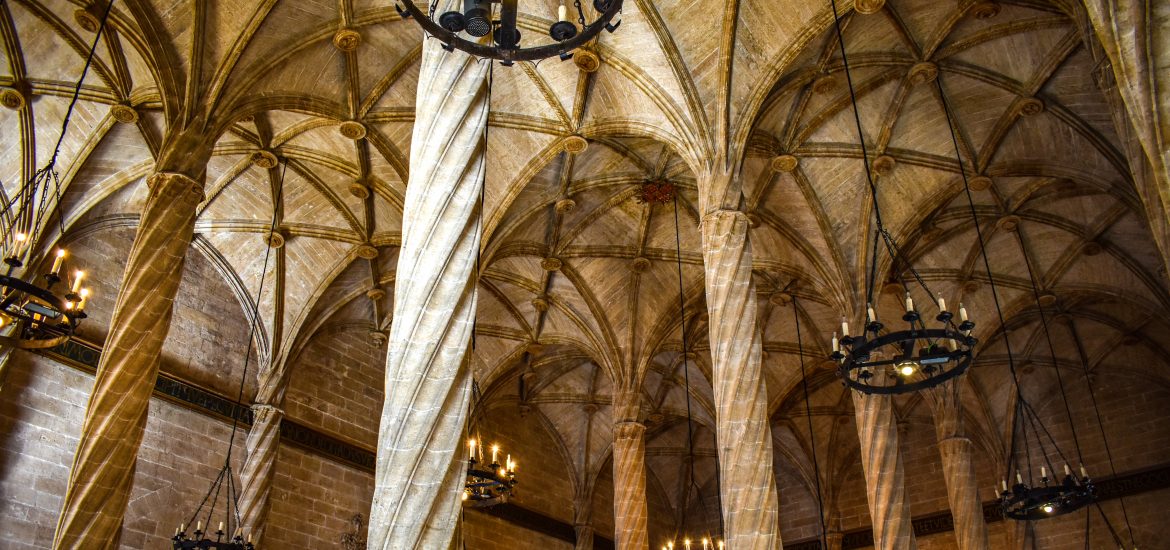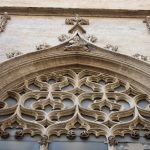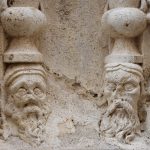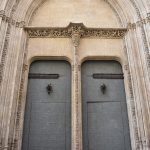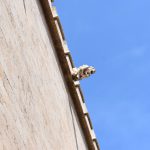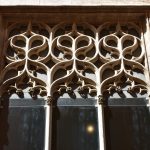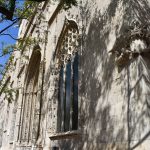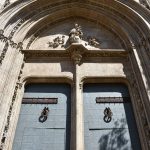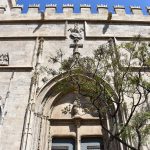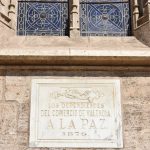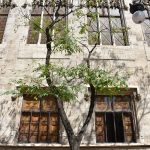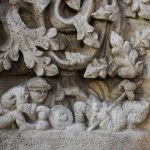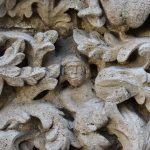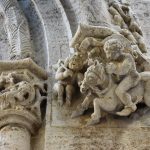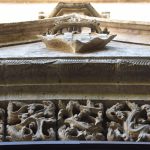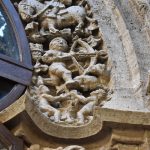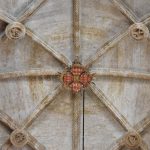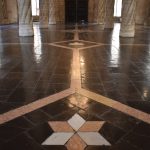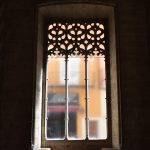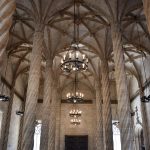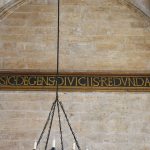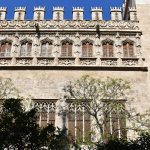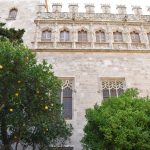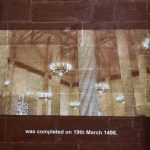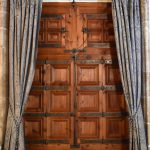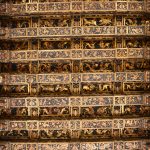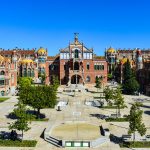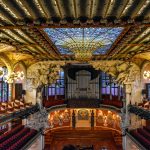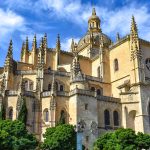As commented by the UNESCO:
Built between 1482 and 1533, this group of buildings was originally used for trading in silk (hence its name, the Silk Exchange) and it has always been a centre for commerce. It is a masterpiece of late Gothic architecture. The grandiose Sala de Contratación (Contract or Trading Hall), in particular, illustrates the power and wealth of a major Mediterranean mercantile city in the 15th and 16th centuries.
瓦伦西亚丝绸交易厅: 该建筑群建于公元1482年至1533年间,原用于丝绸贸易,并因此得名为丝绸交易厅,从此,那里一直都是进行商贸交易的中心。作为哥特式晚期的建筑杰作,宏伟的交易大厅还是公元15世纪至16世纪地中海地区主要商业城市权力和财富的象征。
The Silk Exchange (La Lonja de la Seda), also called the Merchant’s Exchange (Lonja de los Mercaderes) was constructed between 1482 and 1548, led by the principle architect and stonemason Pere Compte.
In the 15th century, Valencia’s commercial prosperity reached its peak thanks to the important silk industry as well as the trade of other materials. They brought commercial and social revolution to the city. Nevertheless, why did the trade of silk and other materials prosper here in Valencia? It’s because of the geological location of it, a city playing the role of both the start and the end of considerable economic transactions.
Because of this prosperity, the General Council of the City saw the necessity and opportunity and initiated the construction of La Lonja de la Seda. Nowadays, this building has become a witness to the Valencian Golden Age and a representative monument of the civic Gothic style. It was declared a National Monument in 1931 and a UNESCO World Heritage site in 1996.


1. Practical information
1.1 Opening hours
Tuesday to Saturday: 10:00 – 19:00
Sundays and bank holidays: 10:00 – 14:00
Closed on: 1st and 6th January, 1st May and 25th December.
1.2 Ticket prices
General admission ticket: 2 euros
BONO: 6 euros (valid for three days).
Reduced rate: 1 euro
- Groups of ten or more people
- University students as well as school students younger than 16 years old
- Retired people
- Large family members (need to present supporting documents)
- Holders of the Joven Carnet
Free entrance:
- Sundays and bank holidays
- 18th of April (International Day of Monuments and Sites)
- 18th May (International Museum Day)
- 16th November (International Day of World Heritage)
- Children younger than 7 years old
- School groups accompanied by a teacher or responsible person
- Citizens in legal unemployment situations (need to present proof)
- Guides authorized by the Department of Tourism, duly accredited
- Users of the “Valencia Card” and “Valencia Cruise Card” and “Discount Card”
For more information about free entrance or discounted price please click here to read more. However, the information is in Spanish so I’m not sure whether it’s worth the trouble or not saving 1 or 2 euros… Anyway, I was really shocked when I saw that the full entrance ticket was only 2 euros…
1.3 Audio guide
Based on my own experience, I strongly recommend renting an audio guide, which coats around 3 euros (I can’t remember exactly how much now). There are in total 20 info points that you can go to and listen to the guide, from the outside to the inside of the building, from the façades to the roofs, from the sculptures to the windows, from the gates to the stairs, from the the garden to the rooms and so on. Without an audio guide, you can easily have a walk and finish your visit in 20 mins. In contrast, with an audio guide, it will take you more than 1 hour to finish your visit, but you will learn so much more that you will even understand what each sculpture stands for. Well, if you think it’s too detailed and you’re getting bored listening to each of the sculptures, you can skip it easily.

When you rent your audio guide, the employee at the reception will give it to you together with a map, as you can see from the picture above (you need to return the map together with the audio machine after your visit). On this map there are 20 info points that you should go to and look at specific items such as sculptures, façades, windows, gates, decorations, ceiling etc. accompanied by an explanation. By the end of each explanation, the guide will tell you where to go next and where to look at. You just need to follow what the guide says and I think it’s rather easy to catch up (unlike using the audio guides in some other attraction, I couldn’t even catch up with where he’s telling me to go or what to see…). Please note that there are 10 info points outside the building, which means that after you rent the audio guide, you need to get out of the building and walk along the exterior of the building following the guide. After you finish the 10 points outside you need to re-enter the building and don’t forget to show your audio guide so the ticket-controller will let you in.
1.3 How to get there
Address: Llotja de Mercaders, Carrer de la Llotja 2, 46001 València, Spain.
Bus:
- No.7, No.27 and No.73 to stop Mercat Central – Llotja
- No.4, No.8, No.9, No.11, No.16, No.28, No.70 and No.71 to stop Reina
2. Explore the Civic Gothic Silk Exchange


In this chapter, I’ll introduce to you besides the exterior of the building, what you can visit inside the building. Because of the different names of the rooms, it might be a bit confusing the moment you read the map or the floor plan. However I can tell you that once you enter the garden from the reception, you are in the Orange Tree Courtyard. The pavilion in front of you is called Pabellón del Consulado (Pavilion of the Consulate) or Consulado del Mar (Consulate of the Sea). You can visit two floors in this pavilion, that is to say the Tribunal del Comercio (Trade Tribunal) on the lower floor and the main hall and the Cámara del Consulado on the upper floor (the upper floor is accessible from an external staircase located in the garden). The big hall on your left should be the highlight of your visit here. It’s called the Sálon de Contratación (the Trading Hall) or Columnario (the Columned Hall). In between this hall and the pavilion, you can see the Torreón (the Great Tower) from the Orange Garden and you can visit the chapel located on the ground floor of it (you can enter the chapel either from the Trading Hall or from the pavilion of the Consulate). Unfortunately visitors are no allowed to climb up the tower but you can take a glance at the entrance located in the Trading Hall. So, in conclusion, you can visit the Orange Garden, the Trading Hall, the ground floor of the Great Tower (the chapel) and the lower and upper floor of the Pavilion of the Consulate. Remember, what I was talking about above was just about the interior of the Silk Exchange, do follow the audio guide and listen about the exterior of the building as well because it’s also a part of the heritage, and not a small part. In the next sections I’ll give a brief introduction to the Trading Hall, the Great Tower and the Pavilion of the Consulate so you can have a basic knowledge of the structure and history of the building. If you have any more questions or you wanna know more detailed information about certain parts please don’t hesitate to contact me.
2.1 The exterior of the Silk Exchange



As you can see from the pictures above in this section, the Silk Exchange is so rich in sculptures that 10 out of the 20 info points explained by the audio guide are focusing on the exterior of the building. The sculptures are everywhere, on the façades, at the corner, above and around the gates, on the roof, around the windows and so on. With an audio guide, they are more than just sculptures. Instead they depict the Royal arms of the Kingdom of Valencia as well as vivid historical figures such as the kings, queens and religious figures such as the Virgin Mary and angels etc. Some of the sculptural groups are also symbols of certain historical or religious events. Do pay attention to the Gargoyles, who have been standing on the roof watching the traders, Valencian citizens and us visitors for more than 5 decades. In one word, it’s much more interesting to learn about the stories behind them than only watching them as stones. Here in this post I will not explain too much about the figures because first of all, without actually being there on site it’s a bit difficult to point you at certain sculptures and describe. Secondly, I didn’t take pictures of all the detailed sculptures either, because there were really TOO MANY and I was following the audio guide so closely that I didn’t have time to “capture” them in my camera. Anyway, it gives you one more reason to visit it by yourself, doesn’t it?
In the following sections I’ll focus on the Trading Hall, the Great Tower and the Pavilion of the Consulate respectively so you have have an idea of what to expect in your visit.
2.2 The Trading Hall


In order to introduce this hall, I’d like to do it based on the names it is called by the people. The Trading Hall is actually called “the Contracts Hall” in Valencian “Salón de Contratación” because it was the financial centre of La Lonja, used for commercial transactions. A municipal bank called “Taula de Canvis” was also established here in 1407, the first banking institution of municipal character.
The Trading Hall is also called the Columnario (the Columned Hall) and I believe the moment you step in it you will realize why. It is an imposing hall of great beauty characterized by the presence of eight free-standing columns together with another seventeen attached to the sidewalls, serving as buttresses. Completed by Pere Compte in only 15 years, the entire hall is divided into three longitudinal aisles by these twisted columns, which open at the top as palm trees to form fifteen vaults covering the entire interior space. The design of this hall was actually derived from a similar structure in the Lonja of Palma de Majorca, built by the architect Guillem Sagrera, but here it implies the symbolic representation of paradise, in which the columns are the trees and the vaults are the celestial dome.
If you take a close look, you will notice a blue band which runs all along the four walls below the vaults. It might be a bit difficult to see but as shown in the fifth picture in the gallery above, the band is inscribed with golden letters. To be honest, I had no idea what those letters meant, but with the help of the audio guide and as said in Wikipedia, I’ve learnt that:
According to the local Valencian scholar Joan Francesc Mira, this inscription showed that it was not a necessary to be a Protestant or a foreigner to establish the basis of a good trade; it also showed the union of ethics and economy.
It is also in this hall that you will see the entrance to the staircase going up to the Great Tower. I’ll talk more about it in the next section.
2.3 The Great Tower



The tower is a three-storey building connected by a spiral staircase. The ground floor is dedicated to the chapel while the two upper floors were occasionally used by the Tribunal to imprison merchants for debts. To visit the two upper floors you need to climb the spiral staircase but unfortunately it is not accessible to visitors. What you can see now is only the entrance, through which you can take a glance at the staircase, which was a masterpiece at that time because it was made with great technical perfection and without central axis. I learnt from the audio guide that during that period of time, the overall ability of a person as an architect was reflected by his ability to build a staircase. Please note that you will see the entrance from the Trading Hall (info point No. 17) not from the chapel. Do you know why there is a bat crowing the coat of arms of Valencia? Do you know what the sculptures on the vault of the chapel mean? Your audio guide will solve these puzzles for you (or you can write me and ask).
2.4 The Pavilion of the Consulate



The Pavilion of the Consulate (Pabellón del Consulado), also called Consulate of the Sea (Consulado del Mar) was built at the beginning of the 16th century with a distinctive Renaissance style. It was first designed and built under the supervision of Pere Compte, who unfortunately died before seeing it be completed. Several masters continued to work on it and completed the construction in 1548 and made it what we see nowadays. What’s the most noteworthy on the exterior are the higher parts of the façade, for example, the gallery with arches as well as the forty medallions representing the busts of Roman emperors and distinguished personages, typical of the Renaissance period. In order to have a better view of these parts, I suggest you stand either at the entrance of the Orange Garden or next to the Church of Santos Juanes.
The reason why this pavilion is called Pavilion of the Consulate or Consulate of the Sea is that “it housed an institution of the same name created in the 13th century which was responsible for ensuring that all maritime and mercantile matters were undertaken correctly”.
Having had a look at the exterior, now let’s explore the interior of the building. This pavilion is made up of three parts, namely the basement, the Trade Court on the ground floor and the Consulate of the Sea on the first floor. The ground floor is accessible to visitors either from the chapel or from the garden while the first floor can only be reached by the external staircase located in the garden. Both of the rooms nowadays still keep the original furnishings of the old time and the most attractive features in each of the floors respectively are that on the ground floor, the room housed the Tribunal del Mar, the first marine merchant tribunal to ever be formed in Spain and on the first floor, the 15th-century wooden coffered ceiling, taken from the Golden Hall of the former Town Hall, keeps astonishing all the visitors.
